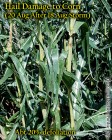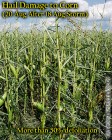![]() ecent hailstorms in areas of the state caused some
defoliation, a lot of leaf tattering, some stalk bruising and some ear bruising
in corn fields unfortunate enough to be in their paths. Yield loss from such
late season hail damage is due primarily to the defoliation, but the extent of
the defoliation can be tricky to quantify.
ecent hailstorms in areas of the state caused some
defoliation, a lot of leaf tattering, some stalk bruising and some ear bruising
in corn fields unfortunate enough to be in their paths. Yield loss from such
late season hail damage is due primarily to the defoliation, but the extent of
the defoliation can be tricky to quantify.
Hail damage to leaves typically looks worse than it really is, because most of us tend to assume tattered leaves will no longer function. This assumption is correct if the tattered leaves actually dry up and wither away. However, if the tattered leaves don’t actually die, they can still contribute to the continued functioning of the photosynthetic factory. Most of the hail-damaged fields I visited today in westcentral Indiana were 20 to 50 percent defoliated and only a few were greater than 50 percent defoliated. For the sake of argument, though, let’s assume on average the defoliation was 50 percent.



Yield loss to defoliation is dependent on the growth stage of the crop. Corn that is pollinating is at most risk of yield loss to hail damage and becomes increasingly less susceptible to yield loss as grain maturation nears. The good news is that most of the fields I walked today ranged from early dent to late dent (half-milkline) and not younger. Using my average defoliation estimate of 50 percent and the range of growth stages observed, the average yield loss from the storms over the weekend would be in the neighborhood of five to nine percent.

Minor bruising of the stalk or ear husks will be of little consequence and should not result in any appreciable development of stalk or ear rots. Where hailstones were large or intense enough to actually gouge into the stalk, then the physical structural integrity of the stalk is compromised and standability may be an issue before harvest. None of the fields I walked today, however, exhibited anything other than minor bruising.


The hailstorms packed quite a bit of wind and significant stalk lodging occurred in some fields from the wind, especially where the corn rows were oriented perpendicular to the direction of the wind. The good news, though, is that most of the lodging appears to be more of a stalk leaning and not actually stalk breakage.

A minor bit of good news is that the significant defoliation in these hail-damaged fields may actually contribute to faster grain drydown because of better wind movement through the damaged crop canopy. Grain maturation timing may be hastened a bit, also.

 For other
information about corn, take a look at the Corn Growers Guidebook on the World
Wide Web at http://www.kingcorn.org
For other
information about corn, take a look at the Corn Growers Guidebook on the World
Wide Web at http://www.kingcorn.org